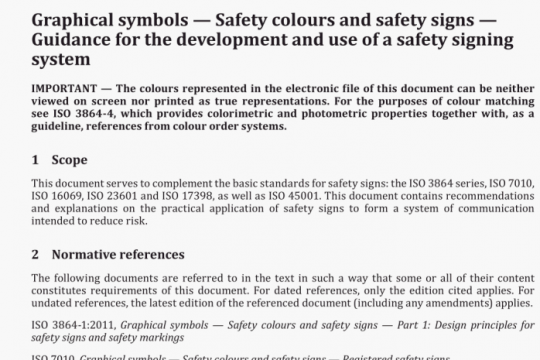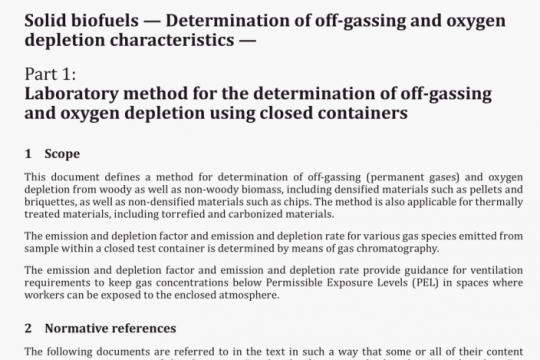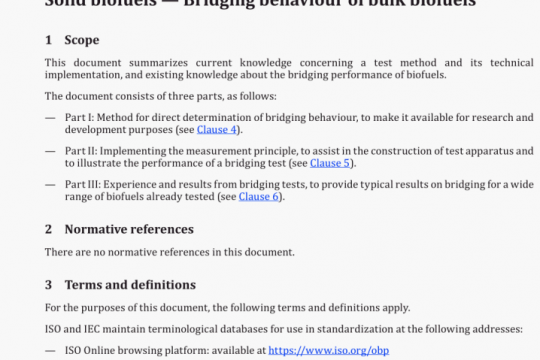ISO 8178-4 pdf free download
ISO 8178-4-2020 pdf free download.Reciprocating internal combustion engines – Exhaust emission measurement一 Part 4: Steady-state and transient test cycles for different engine applications.
When the maximum test speed (MTS) defined in 34 is being used in place of rated speed to run the test cycle then this speed may be used in place of rated speed when setting the intake air restriction.
5.3.3 Engines with charge air cooling
A charge-air cooling system with a total intake-air capacity that represents the production engine’s in- use installation shall be used. Any laboratory charge-air cooling system shall be designed to minimize accumulation of condensate. Any accumulated condensate shall be drained and all drains shall be completely closed before emission testing. The drains shall be kept closed during the emission test. Coolant conditions shall be maintained as follows:
a) A coolant temperature of at least 20 °C shall be maintained at the inlet to the charge-air cooler throughout testing.
b) At the rated speed and full load, the coolant flow rate shall be set to achieve an air temperature within ±5°C of the value designed by the manufacturer after the charge-air cooler’s outlet. The air- outlet temperature shall be measured at the location specified by the manufacturer. This coolant flow rate set point shall be used throughout testing.
c) lithe engine manufacturer specifies pressure-drop limits across the charge-air cooling system, it shall be ensured that the pressure drop across the charge-air cooling system at engine conditions specified by the manufacturer is within the manufacturer’s specified limit(s). The pressure drop shall be measured at the manufacturer’s specified locations.
When the maximum test speed (MTS) defined in i4Q is being used in place of rated speed to run the test cycle then this speed may be used in place of rated speed when setting the charge air temperature.
The objective is to produce emission results that are representative of in-use operation. If good engineering judgment indicates that the specifications in this clause would result in unrepresentative testing (such as overcooling of the intake air), with the prior agreement of the parties involved more sophisticated set points and controls of charge-air pressure drop, coolant temperature, and flow rate may be used to achieve more representative results.
5.4 Engine exhaust system
5.4.1 General
The exhaust system installed with the engine or one that represents a typical in-use configuration shall be used. The exhaust system shall conform to the requirements for exhaust gas sampling, as set out in
5.4.2 Exhaust restriction
An engine exhaust system or a test laboratory system shall be used presenting a static exhaust backpressure within 80 % to 100 % of the maximum exhaust restriction specified by the manufacturer at the rated speed and full load. The restriction may be set using a valve. If the maximum restriction is 5 kPa or less, the set point shall not be more than 1,0 kPa from the maximum.
When the maximum test speed (MTS) defined in 3AL is being used in place of rated speed to run the test cycle then this speed may be used in place of rated speed when setting the exhaust restriction.
5.4.3 Engine with exhaust after-treatment system
If the engine is equipped with an exhaust after-treatment system, the exhaust pipe shall have the same diameter as found in-use, or as specified by the manufacturer, for at least four pipe diameters upstream of the expansion section containing the after-treatment device. The distance from the exhaust manifold flange or turbocharger outlet to the exhaust after-treatment system shall be the same as in the in- use configuration or within the distance specifications of the manufacturer. Where other installation requirements are specified by the manufacturer these shall also be respected for the test configuration.
The exhaust restriction shall be set according to £42. For variable-restriction after-treatment devices, the maximum exhaust restriction used in £42 is defined at the after-treatment condition (degreening/ ageing and regeneration/loading level) specified by the manufacturer. The after-treatment container may be removed during dummy tests and during engine mapping, and replaced with an equivalent container having an inactive catalyst support.
5.5 Specific test conditions
5.5.1 Engine with exhaust after-treatment system
The emissions measured on the test cycle shall be representative of the emissions in the field.
5.5.1.1 Use of reagent
In the case ofan engine equipped with an exhaust after-treatment system that requires the consumption of a reagent, the reagent used for all tests shall be declared by the manufacturer.
5.5.1.2 Regeneration
For engines equipped with exhaust after-treatment systems that are regenerated on an infrequent (periodic) basis, as described in 5.5.1.2.2. emission results shall be adjusted to account for regeneration events. In this case, the average emission depends on the frequency of the regeneration event in terms of fraction of tests during which the regeneration occurs. After-treatment systems with continuous regeneration according to 5iLZJ. do not require a special test procedure.
If the exhaust aftertreatment has a security mode that works on an infrequent (periodic) regeneration mode, it shall be checked according to 5.5.1.2.2. For that specific case, the applicable emission limits could be exceeded and the measured emissions would not be weighted.
5.5.1.2.1 Continuous regeneration
For an exhaust aftertreatment system based on a continuous regeneration process, the emissions shall be measured on an aftertreatment system that has been stabilized so as to result in repeatable emissions behaviour. The regeneration process shall occur at least once during the NRTC hot start test, LSI-NRTC or NRSC test, and the manufacturer shall declare the normal conditions under which regeneration occurs (soot load, temperature, exhaust back-pressure, etc.). In order to demonstrate that the regeneration process is continuous, at least three NRTC hot start tests, LSI-NRTC or NRSC tests shall be conducted. In case of NRTC hot start test, the engine shall be warmed up in accordance with SA..2, the engine shall be soaked according to 8.6,3 and the first NRTC hot start test run. The subsequent NRTC hot start tests shall be started after soaking according to 8.63. During the tests, exhaust temperatures and pressures shall be recorded (temperature before and after the after-treatment system, exhaust back pressure, etc.). The aftertreatment system is considered to be satisfactory if the conditions declared by the manufacturer occur during the test during a sufficient time and the emission results do not scatter by more than ±25 % from the mean value or 0,005 g/kWh, whichever is greater. PN emissions do not need to meet the specified scatter requirement if gaseous and PM emissions meet this requirement. If the exhaust aftertreatment has a security mode that shifts to an infrequent (periodic) regeneration mode, it shall be checked according to 5.5.1.2.2. For that specific case, the applicable emission limits could be exceeded and would not be weighted.
5.5.1.2.2 Infrequent (periodic) regeneration
This provision only applies for engines equipped with emission controls that are regenerated on a periodic basis.
Testing and development of adjustment factors is only required for one applicable transient (NRTC or LSI-NRTC) or RMC test cycle. The factors that have been developed may be applied to results from the other applicable test cycles including discrete-mode NRSC.ISO 8178-4 pdf download.




